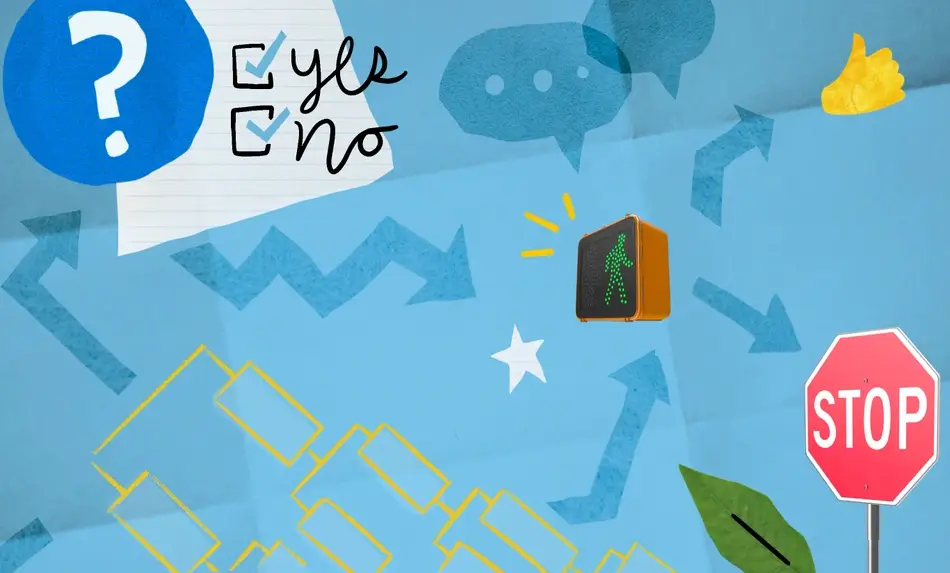How to Improve Your Decision-Making Process, Part 2

Whether it’s at work or at home, decision making is an important part of our lives. Learning how to be a more efficient and effective decision maker is a critical skill—not just for making the best choices, but also for ensuring our own well-being. A healthy state of mind is critical to self-care, and the stress that comes from indecision can be a significant drain on our mental health. Since May is Mental Health Awareness Month, there’s no better time to bone up on how to improve your decision-making process.
In Part 1, we discussed Daniel Kahneman’s concept of System 1 and System 2 thinking to help recognize the differences between “thinking fast” and “thinking slow,” and three ways to prevent System 1 from hijacking our decision-making process. Here, we cover three more methods for ensuring you have both the mental and emotional energy necessary to make sound choices, even under pressure.
Narrow your options and make smaller decisions
We can all appreciate the wisdom of “less is more,” but we rarely apply it to our decision-making process. Our tendency is to think that the more options we have, the more likely we are to make the best and most satisfying choice. However, the research shows that the exact opposite is the case. Having fewer alternatives to choose from and committing to a decision once we’ve made it, often leads to a less stressful decision-making process—and more satisfaction overall.
If you’re faced with an overwhelming number of options, break them into smaller chunks and treat the process like a tournament bracket. Focus solely on one group at a time, putting the others out of your mind until later. Follow this elimination process until you’re left with one last list of the “winners.” Now that your options have been narrowed, you can more confidently move forward with a final decision.
Ask others for input
Part of what makes decision making so emotionally exhausting is the pressure to make the right choice. A great way to relieve that pressure—especially if you don’t have as much time as you’d like—is to ask colleagues for their thoughts.
Much like writing things down, getting the opinions of others is a great way to find alternative perspectives you may have neglected to consider. Sometimes, the simple act of explaining the problem can refresh your own understanding, getting you thinking differently and shaking loose some ideas you may otherwise not have had.
Hearing what others have to say can also help you preserve your own energy and ease some of the pressure of trying to handle the deliberation by yourself. Even if the decision is ultimately yours, sharing the weight of the process with others can help you avoid wearing yourself too thin—which leads us to the final tip:
Avoid decision fatigue
Decision fatigue is the name given to the diminishing returns we get when we’re required to make too many choices in close succession. Our minds can only handle so much before our decision-making process begins to deteriorate, which is why pacing ourselves and learning to say “no” when we are beginning to feel overwhelmed is crucial.
If you have a lot of big decisions to make, try to space them out so you have the time to recharge. Put meals or breaks between decision points so you can make sure you have the energy to be mindful. If you can, spread important meetings out so they aren’t back-to-back, or try to defer the actual decision making to time outside those meetings. Say something like, “I want to review all the information more closely before making a decision on this. How about I get back to you with an answer by Thursday?” This will give you a chance to employ the other tactics we’ve covered and ensure you’re making decisions with System 2 in the driver’s seat.
We know it would be silly to expect our cars to run well on an empty tank and without proper maintenance, but we often lose sight of this when it comes to ourselves. That is why perhaps the most important piece of advice for improving your decision-making process is avoiding burnout. System 1 thinking tends to go haywire when we’re stressed, under pressure, or sleep-deprived, so getting enough rest and minding our health is integral to staying on track. When it comes to improving your decision-making process, as with most considerations, the first and most important step is self-care.
And be sure to check out Part 1 for more tips on improving your decision-making process.
Angel uses his skills as a storyteller to support and inspire job seekers and aspiring social-impact professionals.






